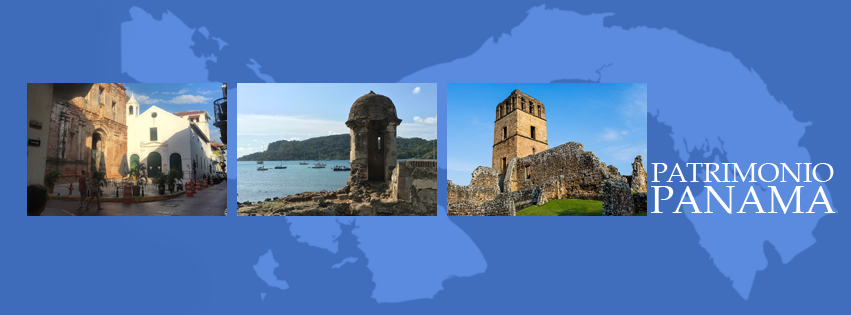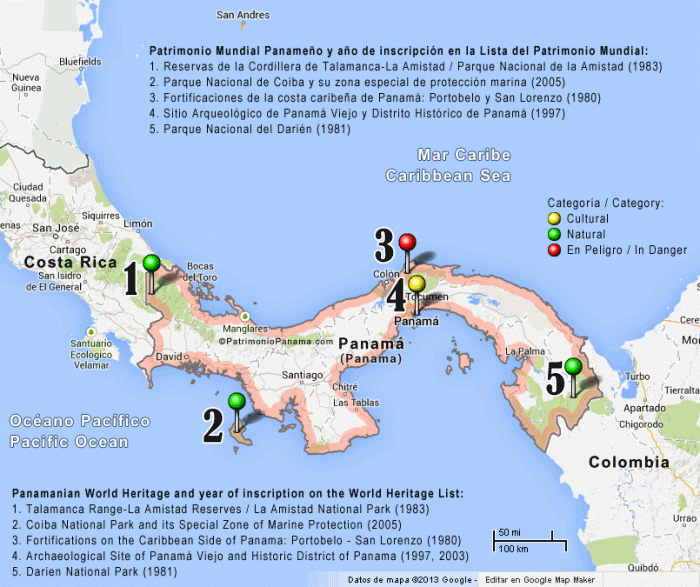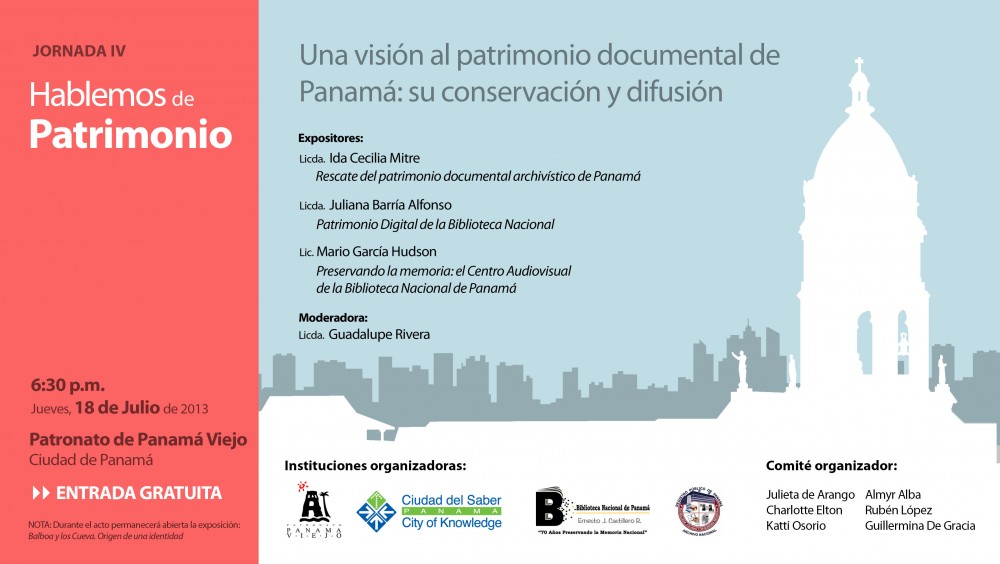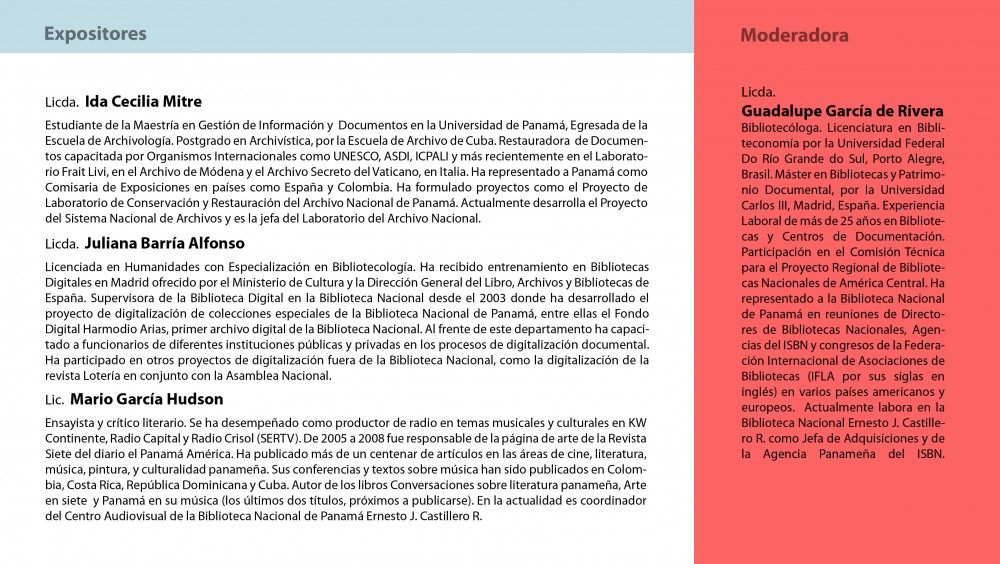To facilitate understanding of the text of the State of Conservation prepared by the World Heritage Centre the United Nations Organization for Education, Scientific and Cultural Organization (UNESCO) for the Panamanian property inscribed on the World Heritage List under entry number 790bis, “Archaeological Site of Panama Viejo and Historic District of Panama” (the name Historic District refers to the Casco Antiguo of Panama City), Here I provide an UNOFFICIAL translation.
The original text in English can be consulted both in the Information System of the State of Conservation of the World Heritage Centre of UNESCO (http://whc.unesco.org/en/soc/1975), and also available in, http://whc.unesco.org/en/documents/123027 (on the pages 184 to 190)
————–
Unofficial translation.
100. Archaeological Site of Panama Viejo and Historic District of Panama (Panamá)
(C 790bis)
Year of inscription on the List of World Heritage
1997, extension at 2003
Criteria
(ii) (iv) (vi)
Year(s) of inscription on the List of World Heritage in Danger
N/A
Previous decisions of the Committee
See: http://whc.unesco.org/en/lis/790/documents/Asistencia Internacional
N/A
UNESCO Extra-Budgetary Funds
N/A
Previous missions monitoring
Previous Missions Monitoring
March 2009: Reactive Monitoring Mission joint World Heritage Centre / ICOMOS
March 2010: Because of the reactive monitoring mission of the joint World Heritage Centre / ICOMOS to Portobelo and San Lorenzo, conducted a technical visit to the Archaeological Site of Panama Viejo and Historic District, as requested by the authorities of Panama.
October 2010: Joint reactive monitoring mission of the World Heritage Centre with ICOMOS.
Factors affecting the property identified in previous reports
to) The serious deterioration of historic buildings that threatens the Outstanding Universal Value;
b) Conflicts of interests of different stakeholders in relation to the use, management and conservation of the historic center;
c) Limited capacity for rehabilitation and maintenance of historic buildings;
d) The deficiencies in the implementation of the legislative framework for the protection;
and) The lack of clear policy implementation and management of the property conservacióno;
f) Demolition of buildings and urban ensembles;
g) The forced displacement of occupants and squatters;
h) Urban development projects within the protected area (namely, Cinta Costera).
Material ilustrativo
See page http://whc.unesco.org/en/list/790
y http://whc.unesco.org / and / soc
Current conservation issues
The State Party submitted a report on the state of conservation of the property 31 th of January, 2013, Additional information was submitted on 12 February 2013. More detailed information on the Cinta Costera III project, including information on the impact of the project and in urban transport and mobility strategy for the Historic District of Panama had been submitted by the State party on 21 September and 9 of November, 2012. The 14 March 2013, the State party made a presentation at the World Heritage Centre on the progress in developing the management plan set of two World Heritage properties in Panama: Fortifications on the Caribbean coast of Panama, Portobelo and San Lorenzo, Historic District plus Panama and Old Panama Archaeological Site.
to) Buffer zone and inventory retrospective
A request for minor changes to the boundaries was presented by the State party on 29 th of January, 2013 and additional information regarding the 15 February 2013. On 14 March 2013 was also presented an additional map. However, the proposed minor modifications to the boundaries does not meet the requirements of the Operational Guidelines, therefore requested the State party clarify and complete information presentation.
b) Legislative Framework, policy and management system for the property.
The information presented includes a progress report on the development and implementation of policies and procedures manual for the restoration and rehabilitation of the Old Town Panama City, which was approved in 2004. The manual makes clear the basic requirements for plan approval and the approval of permits for construction and occupancy. There has been no accurate information on the implementation of these tools.
The state party also provided information on the formulation of the "Panama Plan UNESCO Heritage Management" on a presentation made at UNESCO 14 March 2013. The information provided notes to prepare a protocol for the management of the two cultural World Heritage properties in Panama, August 2012; said the protocol signed by all the major players operating plan ensures. A coordinating body is established and also a National Natural and Cultural Heritage will function as a technical advisory body. The Commission integrates various ministries and management entities Portobelo and San Lorenzo, well as Panama Viejo. Presidential Decree to establish a Commission official is under review currently.
The draft Management Plan included in the report presents a list of a number of objectives for both conservation and management of World Heritage cultural properties. The Plan contains background information, an assessment of the current situation and the strategies and actions proposed for the various sectors, structured under the following headings: Knowledge plan, protection and conservation plan, urban planning, plan public space and landscaping, economic development plan, cultural promotion plan and monitoring plan. The document also includes a table of actions to be implemented, cost proposed and identified for the execution times (urgent, medium and long term). While the Management Plan includes a useful systematic evaluation and identifies specific activities, would benefit from the identification of a precise route to address the state of conservation of the built environment, criteria and guidance for interventions, that could be used as a consistent framework to guide decision-making, taking into consideration the conditions of authenticity and integrity of the property. Additional information is required as to whether the proposed management arrangements are in operation and whether it has achieved funding to implement urgent actions identified.
The report submitted by the State party also included the Master Plan for the rehabilitation and restoration of the historic monuments of the Old Town Panama City, dated January 2011. No information was given about the degree of implementation of the Master Plan will be essential and clearly integrated with the Management Plan under development.
c) Condition of the property
Since 2008, World Heritage Committee has expressed concern about the state of conservation of the Historic Center, Particularly with regard to the existence of a significant number of historic buildings mostly dilapidated and neglected.
The State party reports progress with certain steps to begin addressing these problems. For example, actions have been carried out for replacement of sidewalks and painting sidewalks cords, to place pavement, for the installation of storm drains, for the underground electrical and communications, and reconstruction of sewerage infrastructure. It also notes that the historic center visits were carried out to monitor the progress of the actions implemented, including the state of conservation of historic buildings.
More detailed information submitted by the State party considers the magnitude of the problem: of the 845 lots in the historic district, 40,3% is considered to be in good condition, on the 5,8% has unfinished works, 9,8% are vacant lots, 26,4% are inhabited and in poor condition and 17,6% are unoccupied and in poor condition. It is claimed that this analysis will be used for summoning their owners to initiate processes “unlocking value” by National Trust (DNPH) and apply sanctions where appropriate. However, no additional information was provided on whether the Emergency Plan interventions, prepared in 2009, revised in accordance with the provisions provided for in Schedule Management Plan to identify priority actions for implementation and to include a practical plan for implementation, including the resources required and the time schedule for implementation. This review has been requested by the World Heritage Committee since its 35th meeting (UNESCO, 2011).
On the Road Cinquantenaire, State party reports that it has continued to work on his removal from the Old Panama Archaeological Site. In consideration of the new alignment, actions are being implemented as archaeological studies, relocation of utilities, and relocation of affected families. As requested by the Environmental Impact Study (EIA), Archaeological Rescue Plan of Panama Viejo was implemented. However, any Heritage Impact Assessment has been done yet for review.
d) Coastal Belt Project
i. Background
Reactive monitoring mission to the property in 2009 Phase II said Cinta Costera project, located in the seaside area of the Embankment, 'd been built without conducting environmental impact studies or heritage impact studies, without informing the World Heritage Committee. Additionally, The mission noted that the Phase III project planned at that time could have an impact on the property; consequently the World Heritage Committee at its 33rd Session (Seville 2009) requested that the State party betray a final report, including the analysis and monitoring of the impacts of the construction of the Cinta Costera Phase II and the potential impacts on the property for the possible continuation of Phase III.
In 2010, the conservation status report considered by the World Heritage Committee at its 34th Session (Brasilia, 2010) noted that was expected at the time that Phase III of the Coastal continue with a tunnel would cross approximately 1 km of the historic center or using surround the Peninsula Historic District. Reactive monitoring mission 2010 verified that the property had continued work on Phase II and it was not possible seek additional information regarding the social, conservation requirements, or project impact assessments. It was also noted that Phase II of the Coastal had resulted in the radical transformation of the coastline and impacted the character of the old port area on the Embankment. The mission noted that the proposal from the Cinta Costera Phase III to encircle the peninsula could have an aggressive impact on targeted views to and from the historic center and could impact on the conditions of authenticity and integrity of the property. He also noted that any alternative to the continuation of the project in Phase III would have been sufficiently explored so far. In Decision 34 COM 7B.113, World Heritage Committee requested the State party to stop the Cinta Costera project and submit the necessary technical studies and impact assessments prior to approval and implementation, and to explore and submit alternative proposals to address the concerns surrounding traffic effectively.
At its 35th Session (UNESCO, 2011) World Heritage Committee noted the commitment made by the State party in the session of the Committee to submit all projects, and studies related to alternative proposals for future works of the Cinta Costera Phase III evaluation, including technical specifications and heritage impact studies. The Committee also requested that the construction of Phase III of the coastal strip was discontinued, because it could potentially have an adverse impact on the outstanding universal value of the property.
The 31 th of January, 2012, the State party submitted, as the only alternative was submitting for consideration and review by the World Heritage Committee, a final proposal to build a viaduct Maritime, Phase III de la Cinta Costera, World Heritage Centre and ICOMOS. In the state of conservation report considered by the World Heritage Centre in its 36th Session (Saint Petersburg, 2012) noted, assessment based on Heritage Impact Study, the project meant a potential threat to the integrity and authenticity of the property as it would transform the traditional form of the Historic District, their appearance in the coastline and irreversibly compromise the relationship between the historic center and the sea and would impact particularly property environment on the peninsula and the uniqueness of the fortified. The World Heritage Centre and the Advisory Bodies consider that had not yet been sufficiently explored alternative solutions, nor had they been presented global technical evaluations to rule out other options. The statement for the evaluation of a single proposal also excluded the possibility of talking about other possible solutions. The World Heritage Committee requested, in Decision 36 COM 7B.103, that impact studies on the outstanding universal value of the property were carried out and also requested the State party to implement a series of measures to address comprehensively the precarious state of conservation of the property.
The 21 th of January, 2013, the State party provided a report “Solutions for the future traffic demand Panama City”, prepared by Halcrow Consulting. This report explains the rapid growth of the city of Panama and and provides details of the traffic problem and asserts that the Maritime Viaduct urban freeways have three lanes in each direction, directly connecting Balboa Avenue and the Avenue of the Poets. The report does not provide details of alternative options to cope with increased traffic recognized (vehicular).
ii Current Situation
The 7 th of September, 2012, the State party made a presentation on UNESCO's “Impact of the Cinta Costera III Marine Viaduct to its outstanding universal value under the criteria currently enrolled C790 Property, Archaeological Site of Panama Viejo and Historic District of Panama”. In further communication with the World Heritage Centre, during September 2012, the State party indicated that the option presented was revised to address impacts identified through the incorporation of mitigation and compensation measures. He stressed that the island of San Felipe, which had been outside the Presidential Palace, had been removed from the final design.
The 24 December 2012, a letter from civil society was received by the Director General of UNESCO providing notification of maritime viaduct construction. The 17 October 2012 a letter from the Permanent Delegation to UNESCO Panama was received in response to the request for information regarding claims to the start of construction. The State party indicated that the impact study submitted in September 2012 for evaluation was considered as formal compliance with paragraphs 6 and 7 the decision of the World Heritage Committee (36 COM 7B.103) and therefore considered that the construction of the Interconnection on Carretera Maritime Viaduct could begin. The letter also confirmed the State party's willingness to receive suggestions, contributions and input on the technical feasibility necessary to optimize the design and reported that delegations World Heritage Committee had visited the site for this purpose. In January 2013, information available in the public domain indicated that nearly 50% Viaduct was built. For official communication, the State party confirmed the day 25 th of April, 2013 that 55% infrastructure has been completed.
iii. Assessment of impacts on the Outstanding Universal Value of the property
The impact study submitted by the State party noted that the Maritime Viaduct, Phase III of the coastal strip does not affect enrollment criteria of the property. However, The report highlighted the attributes of the property in terms of shape and design that influenced the evolution of military architecture in the Americas. Emphasized its low profile and adaptation of the settlement to the shape of the peninsula, and considered the paramount importance of the location and environment, both critical attributes for authenticity Property. The report indicates “the main reason why the city was moved after the destruction of Panama Viejo was the desire to fortify. As the site of the cove was paid (himself) for the construction of a fortified, was selected despite its narrowness. The peninsula had an additional advantage: on their flanks to the east and south beach has an area of sharp rocks that have significantly hindered any attempt to attack from there. Given these characteristics, this environment was an integral part of the defensive system.”
The study highlighted that the current environment and landscape, understood as being composed of the Historic District, Panama Bay around (Estes) and panoramas, Waterfront (waterfront), the skyline of Panama and Ancon Hill, who had remained unchanged in terms of the location of the Historic Center, the atmosphere of sharp rocks to the east and south of San Felipe, about three rocks that appear in historical cartography as “The Three Sisters”, be altered. The report included a photo, taken from Google Earth, corresponding exactly to an eighteenth century map of the city and it further emphasized that “at a distance, Historical Center landscape seems mostly unchanged from the nineteenth century”. The report also mentions that “clear vision, in their perception of foreground and background, is part of the collective memory of the population of the capital”. Indirect impacts identified are classified to include visual effects, impact noise, tides, metropolitan scene background, functional, and territorial relationship on the site. The report acknowledges the indirect visual impacts on the environment of the coastline of the property and the graduates as large to very large changes (209, 213 – 215). Despite these considerations, The report considered that the visual impact on the environment of the coastline could be mitigated by design changes. No technical detail was provided in terms of mitigation measures envisaged to ensure that the viaduct does not adversely impact the environment of the coastline.
Conclusion
The World Heritage Centre and the Advisory Bodies wish to attract the attention of the Committee the current condition of the property, where it is reported that the 44% inventoried historic buildings is in extremely poor condition, a problem that has been unattended since 2008. Although the proposed development of the Management Plan can be viewed as a positive step forward, still no indication that the system is fully operational requirements or that adequate resources have been secured.
To date, despite requests made by the World Heritage Committee, unfortunately there is no indication as to whether the Emergency Plan interventions, outlined in 2009, revised in accordance with the provisions made in the guidelines of the Management Plan in order to identify priority actions and to include a practical plan for implementation, schedules including required resources and expected to implement actions. This needs to be implemented urgently to ensure the conservation and protection of the factory built.
The World Heritage Centre and the Advisory Bodies agree with the need to consider improvements to the road infrastructure to meet growing traffic demands but note that no alternative to the Maritime Viaduct was sufficiently explored and that construction began without giving the World Heritage Committee , and identification of possible recommendations. They take note of the efforts made to conduct impact studies but consider that, despite adverse impacts have been identified with the option selected for the Viaduct Maritime, there was no clear explanation in any of the documents provided on why other alternatives were completely rejected. Also, the report “Solutions for the future traffic demand Panama City” underlines the rapid growth of the City of Panama and the challenges it faces in terms of traffic demand and the urgent need to reorganize the road infrastructure. However, (the report) focuses on justifying why the Maritime Viaduct is the only alternative without considering any alternative or balance their advantages and disadvantages. No justifications supported the viaduct indicating that effectively provide and more importantly, sustainably, long-term solutions to these problems of road traffic.
The World Heritage Centre and the Advisory Bodies underscore the negative visual impacts of the Maritime Viaduct that will adversely impact on and transform the setting of the Historic Centre. They further note that , the Maritime Viaduct is a structure of a very strong shape (.) with a high visual impact which does not integrate harmoniously with the Historic District and establishes an undesirable contrast with regard to its maritime context. They consider that the ability of the property to convey its Outstanding Universal Value, as a fortified settlement in a Peninsula and as a testimony to the nature of the early settlements, with a layout and urban design adapted to a particular context, are being adversely compromised. The urban layout and scale and the relationship between the city and its setting, attributes crucial to the understanding of the evolution of the property, also be impacted adversely.
The Viaduct Maritime, which, when it is completed within a few months, closely encircle the coastline that has been the edge of the Historic District since its founding in the seventeenth century, produced alter the views to and from the historic center. Also, the work already done in this large-scale infrastructure is significantly and adversely impact the integrity and authenticity of the property, in terms of the way it communicates its historic and defensive strategic position in the Central American Isthmus, crucial attribute of its Outstanding Universal Value.
Given the current level and extent of the adverse impact on the outstanding universal value of the property resulting from the construction of the viaduct Maritime and current conservation status of the factory built, on the (Center) World Heritage Advisory Bodies note that the World Heritage Committee may wish to inscribe this property on the List of World Heritage in Danger.
Draft Decision: 37 COM 7B.100
The World Heritage Committee,
- Having examined Document WHC-13 /37.COM/7B.Add,
- Recalling Decisions 33 COM 7B.141, 34 COM 7B.113, 35 COM 7B.130, 36 COM 7B.103, adopted at its 33rd (Seville, 2009), 34th (Brasilia, 2010), 35th (UNESCO, 2011) and 36ta (Saint Petersburg, 2012), respectively, and concern that the construction of the Cinta Costera Phase III (Maritime Viaduct) affect adversely on the Outstanding Universal Value of the property,
- Recalling also that the condition reports and reports of reactive monitoring missions March 2009, March 2010 and October 2010 that underscored the impacts of the Cinta Costera project, in particular the Maritime Viaduct, and the poor state of conservation of the property;
- Notes progress in the development of a Management Plan, as to quantify the number of buildings at risk and as for work on urban facades (streetscapes), and underground infrastructure, and reiterates its deep concern about the general state of conservation of the property, and regrets that not enough progress has been made globally in addressing critical issues and sustainable, or implementation of the Plan of Action agreed at 2009;
- Also regrets the fact that the authorities are not yet sufficiently explored alternatives, traffic management solutions to long-term sustainable and decided, unilaterally, proceed with construction of the Cinta Costera Phase III (Maritime Viaduct) and requests the World Heritage Committee at its 33rd, 34th, 35th, and 36th failed to protect property;
- Considers the work already done in building new Maritime Viaduct adversely impacts on property and decide register the property on the List of World Heritage in Danger, in accordance with paragraphs 177 and 179 of the Operational Guidelines;
- Requests the State Party to invite as an urgent issue a joint reactive monitoring World Heritage Centre / ICOMOS to verify the degree of impact that the construction of the Cinta Costera Phase III (Maritime Viaduct) has had on the outstanding universal value of the property and to prepare the Desired State of Conservation, including corrective measures and timetable for implementation;
- Also requests World Heritage Centre and the Advisory Bodies to deliver a report on the findings of the reactive monitoring mission to review and decision by the World Heritage Committee at its 38th Session in 2014.
———
Note 1:
This draft decision was not approved as it was presented to the World Heritage Committee; was reviewed by a special working group, and approved this – http://patrimoniopanama.com /?p = 271)
Note 2:
Thanks to the transparency policies of UNESCO and its World Heritage Centre, all documents cited in this article of the Blog, Patrimonio Panamá are public information of open access for all around the world from UNESCO websites, and by means of the Information System of the State of Conservation (SOC), open to the public from 2012 (Click here to see related news: http://whc.unesco.org/en/news/962/).






